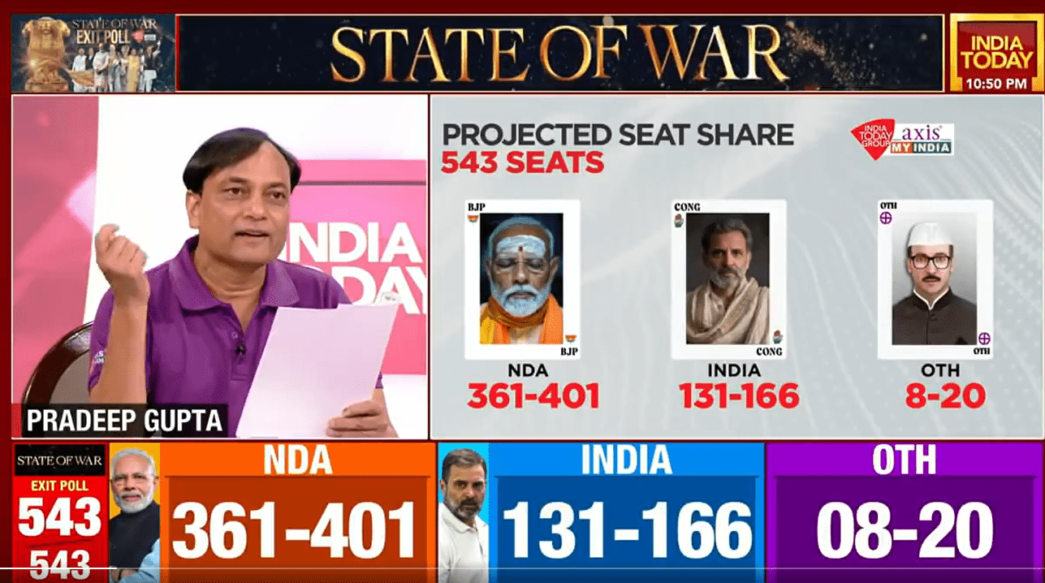New Delhi: As per Axis My India and Aaj Tak, the exit poll conducted by them was the largest ever with over 5 lakh respondents and all 543 seats covered.
Axis My India and its founder Pradeep Gupta are always in news during every election. The research agency and the broadcaster that it partners claim to be correct at the end of most elections.
The claim, however, gets debunked by experts almost every time.
This time too, in the desperation to sound correct at any cost, Pradeep Gupta’s polling agency has given a wide range of 40 seats for NDA (it predicts NDA will get between 361 to 401 seats).
The range given for INDI alliance is also for 35 seats. It has predicted between 131 and 166 seats for the Congress led alliance.
Pradeep Gupta’s numbers have raised serious doubts on the credibility of his research.
By giving such a massive seat margin for both the alliances, he has not just tried to be risk averse but has also tried to camouflage the shortfalls in his methodology.
“The range given should not be more than 15 seats at any cost. What is the point of doing poll research then. Such a wide range can be predicted while sitting in the studios too,” said a senior poll analyst.
“India Today Group should raise a stink on these numbers. Apparently, their ground reporters who have been at the booths do not agree with Pradeep Gupta’s methodology,” the analyst added.
The exit poll has already come under intense scrutiny on social media.
A Dubious Methodology?
One of the primary concerns surrounding Axis My India exit poll is the lack of transparency in its methodology. Critics argue that the poll is shrouded in a “black box” of secrecy, leaving the public in the dark about how the results were derived. Key details such as the sample size and the exact methods used to gather and analyze the data have not been disclosed.
Typically, exit polls rely on a representative sample of voters to predict the outcome of an election. However, when the margin of error is as wide as 40 seats, it raises doubts about the adequacy of the sample size. A larger sample size generally leads to higher accuracy and a narrower range of predictions. The Axis poll claims to have a sample size of over 5 lakh. With this sample size, the numbers should be accurate and not show a wild range.
Wide margin of error weakens poll
The sample size is a critical factor in determining the accuracy of an exit poll. A larger sample size reduces the margin of error and provides a more precise prediction. Conversely, a smaller sample size can lead to greater variability and less reliable results.
Experts in market research and statistics emphasize that a wide margin of error undermines the purpose of conducting an exit poll.
The fundamental goal is to offer a close approximation of the final results, allowing the public and political analysts to gauge the potential outcome with a reasonable degree of confidence. A margin as vast as 40 seats deviates from this objective, making the poll appear more speculative than informative.
Credibility at Stake
The credibility of exit polls hinges on their ability to provide accurate and reliable predictions. When an exit poll presents a range as broad as the one suggested by Aaj Tak Axis, it not only raises doubts about the poll’s accuracy but also casts a shadow over the organization’s reputation. Claiming credit for predictions that span such a wide margin seems more like a desperate attempt to cover all possible outcomes rather than a confident assertion based on robust data.
In conclusion, the Axis My India exit poll’s 40-seat margin has sparked a wave of skepticism and criticism. The lack of transparency regarding the methodology, sample size, and data analysis further fuels the controversy. For exit polls to serve their intended purpose, they must adhere to rigorous standards of accuracy and transparency. Until these questions are addressed, the reliability of such predictions remains in doubt, leaving voters and analysts alike to question their true value











